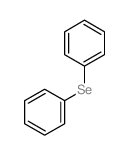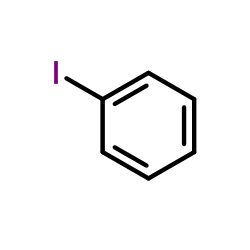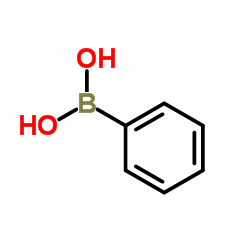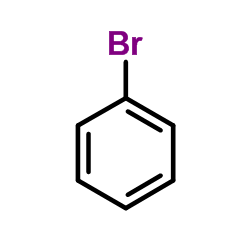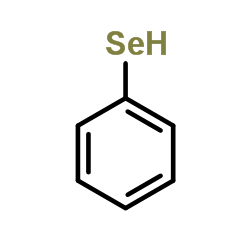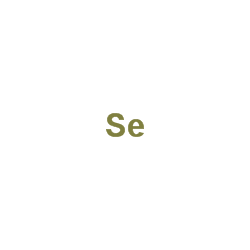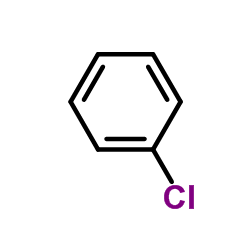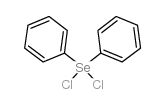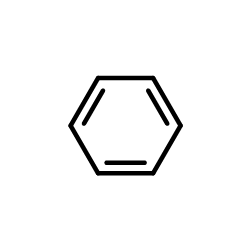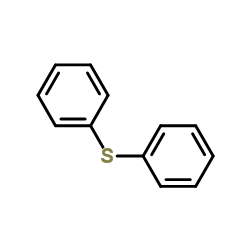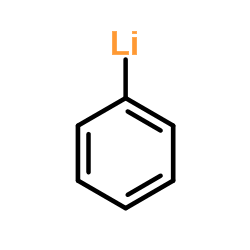1132-39-4
| Name | phenylselanylbenzene |
|---|---|
| Synonyms |
Diphenyl selenide
PHENYL SELENIDE Biphenyl selenide Selenide,phenyl Biphenyl selenium 1,1'-Selenobisbenzene Benzene,1,1'-selenobis Diphenyl selenium MFCD00014067 EINECS 214-474-3 |
| Density | 1.338 g/mL at 25ºC(lit.) |
|---|---|
| Boiling Point | 115-117ºC(lit.) |
| Melting Point | 3ºC |
| Molecular Formula | C12H10Se |
| Molecular Weight | 233.16800 |
| Flash Point | >230 °F |
| Exact Mass | 233.99500 |
| LogP | 1.34160 |
| Vapour Pressure | 0.00188mmHg at 25°C |
| Index of Refraction | n20/D 1.6465(lit.) |
| Storage condition | 2-8°C |
Synonym:Diphenyl selenium; Phenylselenide; 1,1'-Selenobisbenzene; Benzene, 1,1'-selenobis- (9 CI); Biphenyl selenide; Biphenyl selenium; Difenylselenium; Phenyl selenid Section 2 - COMPOSITION, INFORMATION ON INGREDIENTS
Risk Phrases: 23/25 33 Section 3 - HAZARDS IDENTIFICATION EMERGENCY OVERVIEW
Toxic by inhalation and if swallowed. Danger of cumulative effects.The toxicological properties of this material have not been fully investigated. Potential Health Effects Eye: Vapors cause eye irritation. Skin: May cause skin irritation. May be absorbed through the skin. Ingestion: Harmful if swallowed. May cause gastrointestinal irritation with nausea, vomiting and diarrhea. May cause liver and kidney damage. The toxicological properties of this substance have not been fully investigated. Inhalation: Harmful if inhaled. The toxicological properties of this substance have not been fully investigated. May cause dyspnea (difficult or labored breathing). Vapors cause irritation of the respiratory system. Chronic: Prolonged or repeated skin contact may cause dermatitis. Chronic selenium poisoning is characterized by loss of hair and nails, skin lesions, and abnormalities of the nervous system. Section 4 - FIRST AID MEASURES Eyes: Immediately flush eyes with plenty of water for at least 15 minutes, occasionally lifting the upper and lower eyelids. Get medical aid. Skin: Get medical aid. Immediately flush skin with plenty of water for at least 15 minutes while removing contaminated clothing and shoes. Wash clothing before reuse. Ingestion: Call a poison control center. If swallowed, do not induce vomiting unless directed to do so by medical personnel. Never give anything by mouth to an unconscious person. Get medical aid. Inhalation: Get medical aid immediately. Remove from exposure and move to fresh air immediately. If breathing is difficult, give oxygen. Do NOT use mouth-to-mouth resuscitation. If breathing has ceased apply artificial respiration using oxygen and a suitable mechanical device such as a bag and a mask. Notes to Physician: Section 5 - FIRE FIGHTING MEASURES General Information: As in any fire, wear a self-contained breathing apparatus in pressure-demand, MSHA/NIOSH (approved or equivalent), and full protective gear. During a fire, irritating and highly toxic gases may be generated by thermal decomposition or combustion. Vapors may be heavier than air. They can spread along the ground and collect in low or confined areas. Extinguishing Media: Use extinguishing media most appropriate for the surrounding fire. Use water spray, dry chemical, carbon dioxide, or appropriate foam. Section 6 - ACCIDENTAL RELEASE MEASURES General Information: Use proper personal protective equipment as indicated in Section 8. Spills/Leaks: Absorb spill with inert material (e.g. vermiculite, sand or earth), then place in suitable container. Clean up spills immediately, observing precautions in the Protective Equipment section. Provide ventilation. Section 7 - HANDLING and STORAGE Handling: Wash thoroughly after handling. Do not breathe dust, vapor, mist, or gas. Do not get in eyes, on skin, or on clothing. Do not ingest or inhale. Use only in a chemical fume hood. Wash clothing before reuse. Storage: Keep container closed when not in use. Store in a tightly closed container. Store in a cool, dry, well-ventilated area away from incompatible substances. Section 8 - EXPOSURE CONTROLS, PERSONAL PROTECTION Engineering Controls: Facilities storing or utilizing this material should be equipped with an eyewash facility and a safety shower. Use only under a chemical fume hood. Exposure Limits CAS# 1132-39-4: United Kingdom, WEL - TWA: (listed as selenium compounds): 0.1 mg TWA (except hydrogen selenide, as Se) United Kingdom, WEL - STEL: (listed as selenium compounds): 0.3 m STEL (except hydrogen selenide, as Se) United States OSHA: 0.2 mg/m3 TWA (as Se) (listed under Selenium compounds). Belgium - TWA: (listed as selenium compounds): 0.2 mg/m3 VLE (as Japan: (listed as selenium compounds): 0.1 mg/m3 OEL (except SeH2 SeF6, as Se) Malaysia: (listed as selenium compounds): 0.2 mg/m3 TWA (as Se) Netherlands: (listed as selenium compounds): 0.1 mg/m3 MAC (as Se Spain: (listed as selenium compounds): 0.1 mg/m3 VLA-ED (except hydrogen selenide, as Se) Personal Protective Equipment Eyes: Wear appropriate protective eyeglasses or chemical safety goggles as described by OSHA's eye and face protection regulations in 29 CFR 1910.133 or European Standard EN166. Skin: Wear appropriate protective gloves to prevent skin exposure. Clothing: Wear appropriate protective clothing to prevent skin exposure. Respirators: A respiratory protection program that meets OSHA's 29 CFR 1910.134 and ANSI Z88.2 requirements or European Standard EN 149 must be followed whenever workplace conditions warrant respirator use. Section 9 - PHYSICAL AND CHEMICAL PROPERTIES Physical State: Liquid Color: clear yellow Odor: Not available. pH: Not available. Vapor Pressure: Not available. Viscosity: Not available. Boiling Point: 115 - 117 deg C @ 1.00mm Hg Freezing/Melting Point: Not available. Autoignition Temperature: Not available. Flash Point: > 230 deg F (> 110.00 deg C) Explosion Limits, lower: Not available. Explosion Limits, upper: Not available. Decomposition Temperature: Solubility in water: Specific Gravity/Density: 1.3380g/cm3 Molecular Formula: C12H10Se Molecular Weight: 233.17 Section 10 - STABILITY AND REACTIVITY Chemical Stability: Stable under normal temperatures and pressures. Conditions to Avoid: Incompatible materials, excess heat. Incompatibilities with Other Materials: Strong oxidizing agents. Hazardous Decomposition Products: Carbon monoxide, irritating and toxic fumes and gases, carbon dioxide, selenium/selenium oxides. Hazardous Polymerization: Has not been reported. Section 11 - TOXICOLOGICAL INFORMATION RTECS#: CAS# 1132-39-4: SX1825000 LD50/LC50: CAS# 1132-39-4: Oral, rat: LD50 = 360 mg/kg. Carcinogenicity: Diphenylselenide - Not listed by ACGIH, IARC, or NTP. Other: See actual entry in RTECS for complete information. Section 12 - ECOLOGICAL INFORMATION Section 13 - DISPOSAL CONSIDERATIONS Dispose of in a manner consistent with federal, state, and local regulations. Section 14 - TRANSPORT INFORMATION IATA Shipping Name: TOXIC LIQUID, ORGANIC, N.O.S.* Hazard Class: 6.1 UN Number: 2810 Packing Group: III IMO Shipping Name: TOXIC LIQUID, ORGANIC, N.O.S. Hazard Class: 6.1 UN Number: 2810 Packing Group: III RID/ADR Shipping Name: TOXIC LIQUID, ORGANIC, N.O.S. Hazard Class: 6.1 UN Number: 2810 Packing group: III Section 15 - REGULATORY INFORMATION European/International Regulations European Labeling in Accordance with EC Directives Hazard Symbols: T Risk Phrases: R 23/25 Toxic by inhalation and if swallowed. R 33 Danger of cumulative effects. Safety Phrases: S 20/21 When using do not eat, drink or smoke. S 28A After contact with skin, wash immediately with plenty of water. S 45 In case of accident or if you feel unwell, seek medical advice immediately (show the label where possible). WGK (Water Danger/Protection) CAS# 1132-39-4: No information available. Canada CAS# 1132-39-4 is listed on Canada's NDSL List. CAS# 1132-39-4 is listed on Canada's Ingredient Disclosure List. US FEDERAL TSCA CAS# 1132-39-4 is listed on the TSCA inventory. SECTION 16 - ADDITIONAL INFORMATION N/A |
CHEMICAL IDENTIFICATION
HEALTH HAZARD DATAACUTE TOXICITY DATA
|
| Hazard Codes | T,N |
|---|---|
| Risk Phrases | 23/25-33-50/53 |
| Safety Phrases | 20/21-28-45-60-61 |
| RIDADR | UN 3082 9/PG 3 |
| WGK Germany | 3 |
| RTECS | SX1825000 |
| Packaging Group | II |
| Hazard Class | 6.1 |
| HS Code | 2931900090 |
| Precursor 10 | |
|---|---|
| DownStream 10 | |
| HS Code | 2931900090 |
|---|---|
| Summary | 2931900090. other organo-inorganic compounds. VAT:17.0%. Tax rebate rate:13.0%. Supervision conditions:AB(certificate of inspection for goods inward,certificate of inspection for goods outward). MFN tariff:6.5%. General tariff:30.0% |
